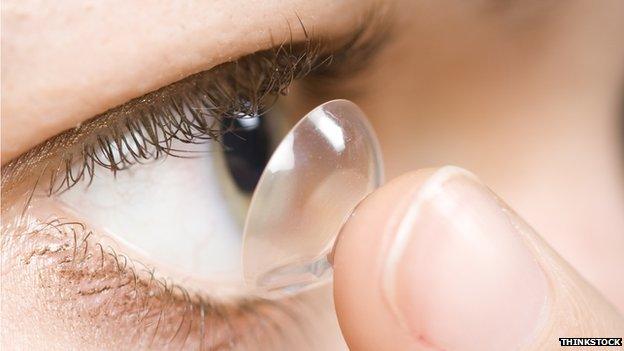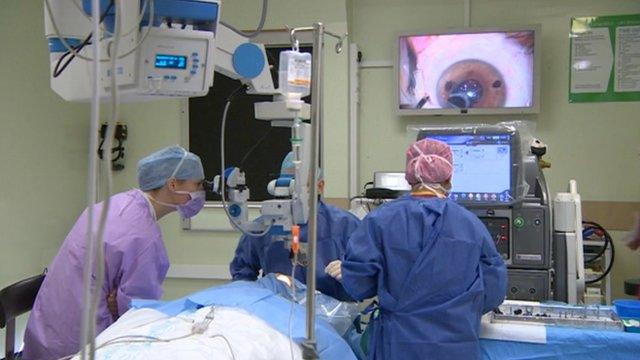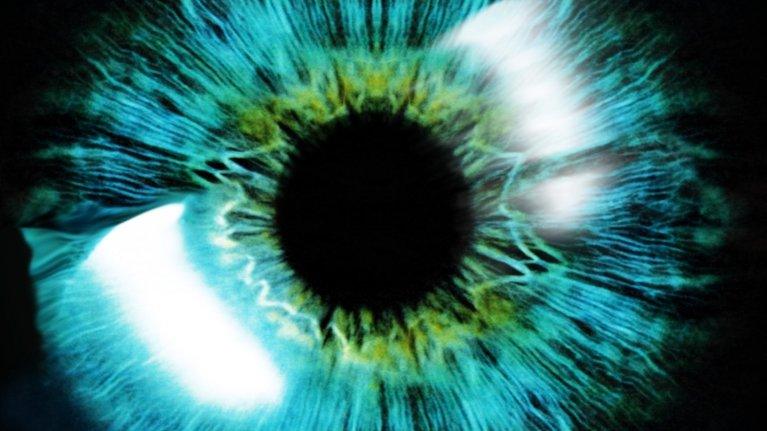The perils of contact lenses
- Published

Specialists at Moorfields Eye hospital have noticed a rise in eye infections among contact-lens wearers and are warning users to take extra care.
Last year, doctors at the hospital treated 60 new cases of a particularly nasty infection called acanthamoeba keratitis - around two to three times more cases than in recent years.
Bacteria, fungi and micro-organisms can stick to contact lenses and cause pain, irritation and serious harm.
One woman, external whose eye became infected from her contact lens has described being kept awake for a week while doctors tried to treat the problem.
Jessica Greaney, 18, a student at Nottingham University, was told the probable cause of the infection was a drop of water which had splashed on to one of her lenses while she was washing them.
"[The parasite] was eating through the cornea of my eye," she told Radio 5 live.
So here are some of the risks, and the dos and don'ts:


Don't sleep with your lenses in
Unless your optician has said you can, it is a bad idea to leave your contacts in when you go to bed.
Most contact lenses are not designed for this and extended wear can aggravate the cornea - the transparent outer covering of the eye - leaving it more vulnerable to infection.


Don't shower or swim with your lenses in
Water can carry and spread a rare but dangerous infection called acanthamoeba keratitis. People who wear contacts are particularly susceptible to the infection, which attacks the cornea. Water-borne bacteria and other bugs, such as acanthamoeba, can attach to contact lenses during swimming and cause infection. This is particularly a problem in public pools where there can often be traces of urine and faecal matter.
If you want to swim with your contacts in, use a pair of tight-fitting swimming goggles to help protect your eyes.


Do clean your lenses properly...
It's essential that you disinfect them as this prevents harmful organisms building up on the lens.
To disinfect your lenses, soak them in solution in a storage case for the recommended amount of time
Never re-use disinfecting solution or top it up. It must be discarded and replaced with fresh solution each time the lenses are stored
Only use the care products recommended by your practitioner, and follow the instructions carefully
Rinse your storage case, leave it open to dry after use each day, and replace it monthly
Clean the storage case each week, using a clean toothbrush and contact lens solution
... and make sure your hands are clean
Wash, rinse and dry your hands thoroughly before handling your lenses to prevent spreading nasty germs


Don't leave them to soak in a glass of water...
It may be tempting to cut corners, especially if you are away from home and have forgotten to bring your lens-cleaning kit. But don't. Tap water, although safe to drink, can still carry bacteria that is harmful to the eyes.
...or lick them
Saliva is not a hygienic way to clean or wet your lenses.


Do be extra careful when putting them in and taking them out
Take care not to catch the lens or the eye with your fingernails
Don't mix your right and left lenses up - get into the habit of inserting and removing the same lens first
Before you put lenses in, check they are not damaged or inside-out. The lens should be shaped like a cup. If it is inside-out it will be shaped like a saucer, with the edges facing out
Give the lens a rinse with saline or conditioning solution (depending on the type of lens) and place it on to the tip of the index finger of your dominant hand
Pull the lower eyelid down with the middle finger of the dominant hand and lift the upper eyelid with your other hand and gently place the lens on the eye without blinking
When the lens is on the eye, close the eye slowly and blink gently a few times until the lens begins to feel comfortable
To remove soft lenses, keep your chin down and look upwards
Separate you eyelids in the same way as before and slide your contact lens down on to the white of your eye. Then gently pinch the lens with your thumb and index finger. Never use your nails
To remove hard lenses, place your middle and ring finger at the outer corner of your eye and pull your eyelids tight over towards your ear. Blink - the lens should come out
Dispose of or store the lenses appropriately.


What if my eye is red or feels odd?
Never ignore problems or discomfort. Remove the contact lens and seek medical advice.
- Published18 May 2015

- Published2 July 2013
